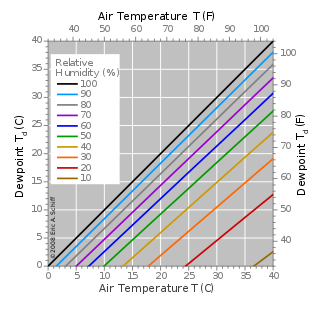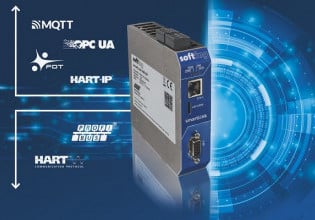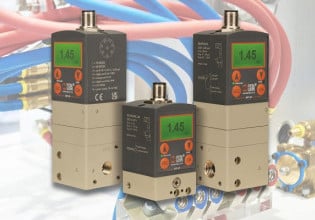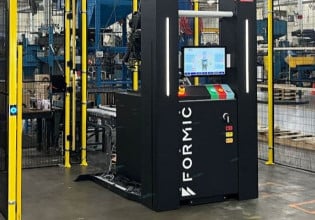Humidity Measurement Basics: Relative Humidity, Sensors, and Applications
Humidity control is vital in many industrial applications. We'll take a look at nine different humidity measurement technologies, how they are used, and discuss the difference between relative humidity and dew point.
Our daily weather forecast tells us relative humidity (RH), maybe also dew point. We often monitor the humidity in our homes. Many industrial and commercial applications require humidity control, not just measurement. Industrial measurements need to be accurate, reliable, and rugged enough for continuous use.
How is humidity measured? Sensors range from simple desktop dial pointers to complex industrial, meteorological, and laboratory setups. We’ll look at several methods, their complexity, accuracy, and reliability. First, let’s review the difference between RH and dew point.
Dew Point vs Relative Humidity
Relative humidity (RH) measures the amount of moisture in the air versus the maximum it can hold. At 50% RH, it has only half the water it can hold. Cold air holds less than warm so, for the same moisture content, RH goes up as the temperature drops. If it cools enough, the humidity rises to 100% and water condenses—dew forms. The temperature now equals the dew point (DP). Dew point is expressed as degrees (the temperature where dew forms), but it is a function of the actual amount of moisture in the air, which is known as absolute humidity.
How do we calculate dew point from RH—or vice versa? The equations are complex, and include temperature. Most are approximations, not exact. One commonly used is the Magnus Formula, which you can find in a web search. Above 50% RH, the following is said to be accurate to about 1%:
Dew Point (deg. C) = Temperature (deg. C) – (100 - RH)/5
+3% RH uncertainty equals about +0.6 ℃ (1.1 ℉) dew point. For on-line conversion calculators, search for “calculate dew point”. A handy conversion chart is shown in Figure 1.

Figure 1. Humidity conversion chart. Image used courtesy of Easchiff
Humidity Sensor Technology
In this article we cover nine different technologies, from simple to very complex. Table 1 summarizes them.
|
Measurement Technology |
Advantages, Limitations, Notes |
|
Mechanical – Dial & Pointer |
Measures RH. Low cost – consumer products. Limited accuracy – up to +10% RH. |
|
Capacitive – MEMS ICs |
Measures RH. Just ICs – need readout circuitry. Accuracy typically +2 to 5% RH. Wide temperature range. Low cost, readily available, multiple sources. Easily applied. |
|
Capacitive – Aluminum Oxide |
Measures absolute humidity, trace amounts, very low dew points. Industrial probes & instruments available. Typ. +2 ℃ DP accuracy. Typical application – trace moisture in natural gas & others. |
|
Chilled Mirror |
Measures dew point. Very accurate - can be a laboratory standard. Complex, expensive, requires periodic cleaning & maintenance. |
|
Wet/Dry Bulb Psychrometers |
Can calculate RH or dew point from wet bulb depression. Needs air flow for proper measurement. Accuracy can be +2 to 5% RH. |
|
Resistive Sensors |
Not commonly used – we found only limited info. Temperature sensitive, nonlinear. Avoid wet water. |
|
Oscillating Quartz Crystal |
Measures absolute humidity, dew point. Very sensitive to trace amounts & small changes. One industrial system claims +10% of reading down to 1 ppm moisture. |
|
Thermal Conductivity |
Moist air cools heated sensors more than dry air. Not just a simple sensor – would require a complete system. |
|
Infrared |
Measures absolute humidity. Complex system. Water vapor absorbs some wavelengths, not others. |
Table 1. Summary of nine humidity measurement technologies.
Mechanical, Dial & Pointer (RH)
These are desktop-type consumer products, not very accurate. We’ll just mention them briefly. A water absorbent material such as hair, wool, or other material, is stretched and linked to a pointer which moves as humidity is absorbed. Alternately, the sensor may be a layer of paper bonded to thin metal, wound in a coil. Accuracy can be as loose as 10% RH.
Capacitive MEMS IC Humidity Sensors (RH)
MEMS electronic sensor ICs have created a simple solution to humidity measurement. Costing only a few dollars, they combine a capacitive sensor with measurement circuitry, and digital or analog output, on a single microchip. Most also measure temperature. Of course, additional circuitry is needed to create a complete product.
How do they work? A capacitor with a moisture-sensitive dielectric (usually polymer) is deposited on a silicon chip, along with the electronics. Capacitance increases or decreases as the dielectric absorbs or gives up moisture. The measurement range is 0 to 100% RH over an extended temperature range. Typical accuracies are +2 to 5% RH.
Fully assembled chips look similar to surface mount ICs, but with openings for their sensors. Along with weather monitoring, they serve many indoor measurement and control applications, including warehouse and manufacturing environments, as well as household and office air conditioning.

Figure 2. Industrial aluminum oxide dew point sensor. Image used courtesy of Servomex
Capacitive Aluminum Oxide Sensors (Dew Point/Absolute Humidity)
These also are capacitive, but are entirely different from MEMS IC sensors. They are rugged, industrial probes which measure trace amounts of moisture. They measure absolute humidity (which can be expressed as dew point), not RH. Figure 2 shows a typical probe.
The dielectric is a thin, porous layer of nonconductive aluminum oxide, often etched or deposited on a metal aluminum rod which becomes the first electrode. The second, permeable electrode layer is deposited on top. In use, the sensor usually is shielded by a protective enclosure. Like polymer, it absorbs moisture. Unlike polymer, the change is proportional to absolute humidity and is sensitive to very small amounts of moisture. The measurement range can go as low as -100℃ dew point.
These are sold as complete industrial systems, including instrumentation, with dew point accuracies around +2 ℃. An important application is monitoring for trace moisture in gasses, including natural gas and propane pipelines.
Chilled Mirror Dew Point Sensors
The concept is simple—cool a mirror while measuring its temperature. When dew forms, the temperature equals the dew point. Figure 3 diagrams the system.

Figure 3. Chilled mirror. The reflected light is interrupted when dew condenses on the mirror.
Light reflected from an LED detects dew formation. When dew forms, the reflected light drops. Some systems include a scattered light sensor whose output increases with dew. Control electronics hold the temperature at the temperature where dew forms.
This is a basic, fundamental measurement and can be very accurate, even well below freezing. It’s used in laboratories and as a calibration reference. It is expensive, though, and requires periodic cleaning and maintenance. For this reason, it’s not suited for many industrial uses.

Figure 4. A handheld sling psychrometer. Image used courtesy of Fisher Scientific
Wet/Dry Bulb Psychrometer (Wet Bulb Depression)
You’re probably familiar with this—two side-by-side thermometers (bulbs), one covered with a wet sock (wick), the other dry. Evaporation cools the sock. Charts and equations convert the readings to RH, dew point, or absolute humidity. For proper evaporation and accuracy, there should be air flow. Figure 4 shows a sling psychrometer which you whirl around in the air. In continuous measurement systems, a fan creates the air flow.
Per ASTM standard EE337-02, accuracy can be +2 to 5% RH. Watch out for salt buildup in the wick.
Resistive Sensors
Resistive humidity sensors place a pair of electrodes on a salt or conductive polymer and measure the resistance between them. This is less sensitive than capacitance, quite nonlinear, and highly temperature dependent. Humidity measurement would need fairly complex circuitry, including temperature measurement. A search yielded only one older sensor, without electronics.
One web site said, “A robust sensor with a humidity accuracy of up to 3% exists today.” We could not find it.
Oscillating Quartz Crystal Sensors (Absolute Humidity)
Quartz crystals can oscillate at very precise, fixed frequencies. The frequency is determined, in part, by mass. If the crystal is coated with a water absorbing material, its mass and frequency will change with humidity. This technology is also called piezoelectric hygrometry, or quartz microbalance hygrometry.
We couldn’t find much detailed information on this technology. We did find an instrument manufacturer whose products are used for trace moisture measurement (absolute humidity) in gasses, down to 0.1 part per million (PPM). Accuracy is +10% of reading from 1 to 2,000 PPM.
Thermal Conductivity Measurement (Absolute Humidity)
Air’s thermal conductivity varies with humidity. A self-heated resistance temperature sensor (wire or thermistor) will change its temperature, and resistance, as humidity varies. A second sensor, not heated, may serve as a reference for ambient temperature. Other than this, we did not find much about this technology.
Infrared Measurement (Absolute Humidity)
Water absorbs some infrared wavelengths, not others. Early in my career, I assisted in an industrial project using infrared to monitor the amount of water in paper and cereals during production processing. Today, this technology also measures water vapor. The details can be complex—we won’t try to tackle them here.
Measuring Humidity
We’ve examined nine humidity measurement technologies, some in more detail than others. We hope this helps you understand and choose the best technology for your application.






